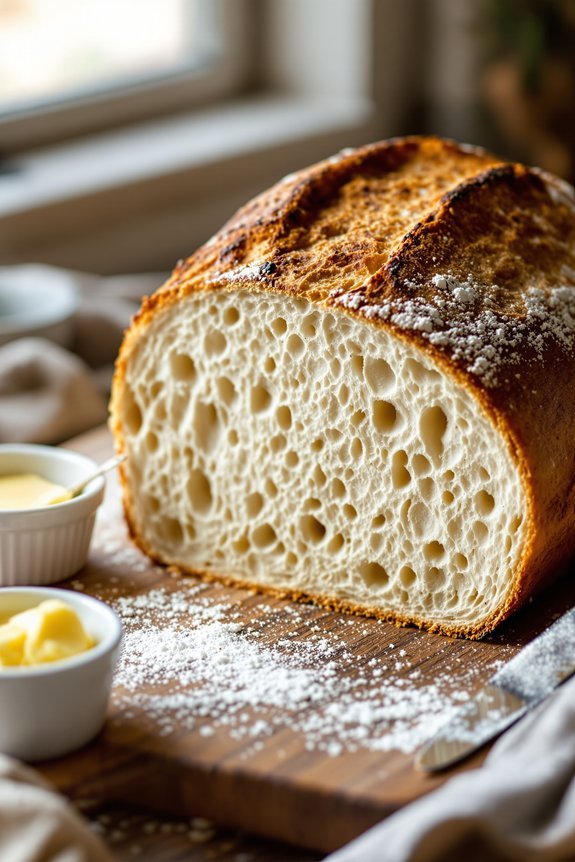Why You’ll Love this Classic Homemade Sourdough Bread
If you’ve been craving that perfect combination of tangy flavor and chewy texture, this classic homemade sourdough bread will absolutely transform your bread-making game. There’s something magical about the way the crust crackles when it comes out of the oven, revealing that soft, airy interior with those gorgeous open holes.
I’m telling you, nothing beats the satisfaction of slicing into bread you’ve nurtured from scratch. The complex flavors develop beautifully with that overnight rise, and your kitchen will smell like a European bakery. Plus, with just a few basic ingredients, it’s surprisingly economical compared to those $8 artisan loaves at specialty shops.
What Ingredients are in Classic Homemade Sourdough Bread?
The beauty of sourdough bread lies in its simplicity. With just a handful of ingredients, you can create something truly magical that has sustained people for centuries. The star of the show is, of course, your sourdough starter—that living culture of wild yeasts and beneficial bacteria that gives sourdough its distinctive tangy flavor and helps it rise without commercial yeast (though this recipe does include some active dry yeast for reliability).
- 1 cup sourdough starter (room temperature)
- 6 cups all-purpose flour
- 1 (1/4 ounce) package active dry yeast
- 1 1/2 cups water
- 3 tablespoons sugar
- 3 tablespoons unsalted butter
- 1 teaspoon salt
- Cornmeal (for dusting)
While the ingredient list is straightforward, the quality of each component matters tremendously. I recommend using unbleached all-purpose flour for the best results, though you can experiment with incorporating some bread flour or whole wheat for different flavors and textures.
The water should be warmed to 120-130°F—hot enough to activate the yeast but not so hot it kills it. And don’t skip the cornmeal for dusting your baking sheet or dutch oven; it prevents sticking and adds that authentic artisan touch to the bottom of your loaf.
Honestly, the most important ingredient might be patience, as good sourdough can’t be rushed.
How to Make this Classic Homemade Sourdough Bread

Making sourdough bread is like orchestrating a beautiful, slow dance between simple ingredients. First, bring your 1 cup of sourdough starter to room temperature—this guarantees those wild yeasts are awake and ready to work their magic.
While that’s happening, combine 2-1/2 cups of the all-purpose flour and the package of active dry yeast in a large mixing bowl, which creates the foundation for your dough.
Next comes the warming of your liquid ingredients. In a saucepan, gently heat and stir 1 1/2 cups water, 3 tablespoons sugar, 3 tablespoons unsalted butter, and 1 teaspoon salt until the mixture reaches about 120-130 degrees Fahrenheit and the butter is almost completely melted.
This warm mixture serves two purposes—it activates the yeast and helps incorporate the fat into your dough. Pour this warm mixture into your flour mixture, add your room-temperature sourdough starter, and beat until smooth and well combined, making sure to scrape down the sides of the bowl.
Now comes the meditative part—gradually stir in as much of the remaining flour as you can in the bowl. The dough will start to pull together, but still be a bit shaggy.
Turn your dough out onto a lightly floured surface for kneading, the most therapeutic part of bread making. Work in enough of the remaining flour to create a smooth, elastic, moderately stiff dough, kneading for about 8-10 minutes.
Can you feel the dough changing under your hands? That’s gluten development happening! Shape your finished dough into a ball and place it in a lightly greased bowl, turning once to coat the surface (this prevents it from drying out).
Cover with a clean kitchen towel and let it rise in a warm spot until doubled in size—about 1 to 2 hours depending on your kitchen temperature.
After that first rise, punch down the dough (my favorite stress-relieving step), divide it in half, and let it rest for 10 minutes before shaping into loaves.
A light dusting of cornmeal on your baking sheet prevents sticking and adds that authentic artisanal touch to the bottom crust.
Classic Homemade Sourdough Bread Substitutions and Variations
Countless variations await when you’re ready to experiment with this classic sourdough recipe. You can swap up to half the all-purpose flour with whole wheat, rye, or spelt for heartier flavor and texture.
Feeling adventurous? Mix in dried herbs, roasted garlic, or olives during the final knead.
Don’t have active dry yeast? No problem. You can rely solely on your starter’s natural yeasts—just expect a longer rise time.
For a tangier loaf, let your dough ferment in the refrigerator overnight.
Want a crustier exterior? Place a shallow pan of water on the bottom rack while baking.
What to Serve with Classic Homemade Sourdough Bread
Now that you’ve mastered your homemade sourdough, let’s talk about what to pair with those beautiful, crusty loaves.
Sourdough’s tangy profile makes it perfect for butter—salted, cultured, or herbed. Can’t beat that simple pleasure.
For something heartier, try dipping it in olive oil with balsamic vinegar, or spreading creamy avocado on top.
Want to impress at dinner? Serve alongside hearty soups like tomato bisque or beef stew. The bread’s slight acidity cuts through rich dishes beautifully.
And don’t forget cheese plates—a slice of sourdough elevates every bite of sharp cheddar or creamy brie.
Final Thoughts
While the journey of making sourdough might seem intimidating at first, the results are absolutely worth every minute spent.
There’s nothing quite like slicing into that first crusty loaf you’ve created with your own hands, watching the steam rise as you reveal that perfect, open crumb structure.







